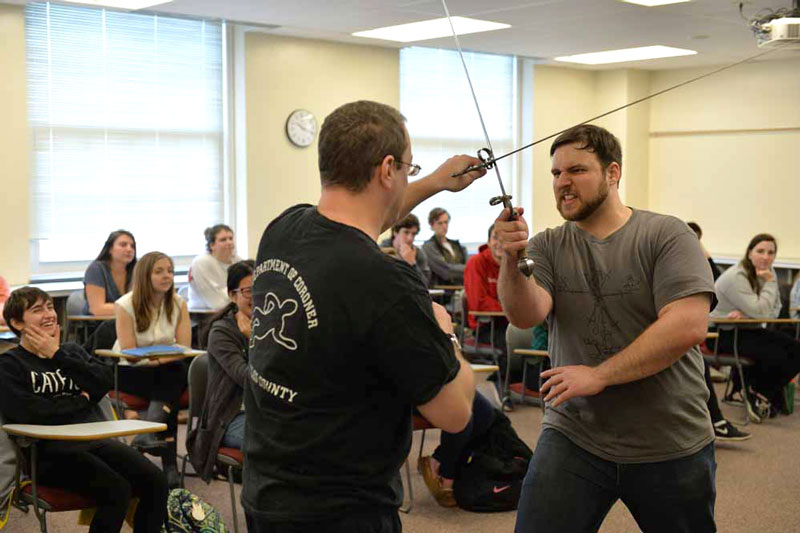Right at your feet, a large man has been tackled to the floor (oof!) with the sharp point of a heavy blade against his chest.
The topic at hand suddenly becomes quite vivid. Adam Davis’s history students weren’t pulled into the fray at knifepoint, but they were impressively close to a clanking, scraping, physical demonstration of medieval weaponry during a Fellows Hall class in “Origins of Europe: Medieval Society.”
Davis saw an opportunity for experiential learning when he came across Frank Zamary (a recent graduate of OSU’s Moritz College of Law) and Jaron Bernstein (a police officer at OSU) — the pair enjoys giving demonstrations of medieval martial arts as an avocation.
“Battling and weaponry aren’t the focus of this course,” said Davis, “but medieval combat has certainly come up, whether while reading the classic heroic tale, The Song of Roland, about Charlemagne’s army’s battles with Muslims in the north of Spain, or in discussing the relationship between lords and vassals and the medieval culture of jousting.” Davis found the presenters to be very knowledgeable and their demonstration “extremely substantive.”
“I think the most engaging part of the talk was discussing the making of the swords, and all of the time and technique that went into these extravagant weapons.”
Students loved handling the swords, and were reluctant to put them down. “Wielding the swords themselves was very cool, and really made you appreciate a well-trained swordsman,” said Garrett Procunier ’17. “I think the most engaging part of the talk was discussing the making of the swords, and all of the time and technique that went into these extravagant weapons.”
“Learning about the armor was also quite interesting,” Procunier added, “and how knights would make their incomes by selling their foes’ swords and armor back to the families of those who were slain.” He appreciated seeing some of the attacks and defenses that were common practice in the 11th and 12th centuries.
Davis points out that history is by necessity learned mainly from the written word, especially going back to the period from 1000 to 1453, the “high and later Middle Ages.” But he adds, “While textual sources can reveal a great deal about a society, there’s nothing quite like artifacts and material objects to bring the past to life.”

